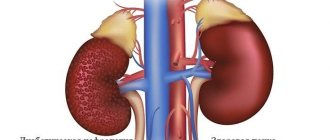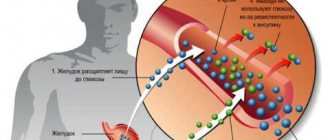Why does ketoacidosis develop (reasons)?
The condition appears due to a sharp decrease in insulin production and the accumulation of excess glucose in the blood. A kind of imbalance arises when glucose is produced from proteins and fats, but the cells starve, since it cannot reach them.
If it is not possible to obtain energy from glucose, then another way to obtain it is through the breakdown of fats. Over time, there is an increase in ketone bodies, which are produced from fat breakdown products. This is how ketosis occurs. There are so many of them that the kidneys cannot cope with their quantity and cannot excrete them. Thus, the breakdown products become acetone, turning into poison and over time poisoning the entire body.
Expert opinion
Guseva Yulia Alexandrova
Specialized endocrinologist
Ask a Question
You can smell it from your mouth and also from your urine. The accumulation of ketones leads to acidification of the blood. Acidosis occurs, that is, the acid-base balance is disturbed.
The indicators for this condition can be found on the card:
Mycelix - for diabetes. Hurry up to get it for free! More details
Diabetic ketoacidosis – what are the symptoms?
In order to recognize the presence of a disease, you need to be familiar with its symptoms. They are developing quite quickly. They are divided into 2 types.
Early symptoms:
- an increased amount of ketones, which is detected in a urine test;
- constant desire to drink water;
- high blood glucose;
- frequent urge to urinate.
Late symptoms:
Our readers write
Topic: Conquered diabetes
From: Galina S. ( [email protected] )
To: Administration aboutdiabetes.ru
At the age of 47, I was diagnosed with type 2 diabetes. In a few weeks I gained almost 15 kg. Constant fatigue, drowsiness, feeling of weakness, vision began to fade.
And here is my story
When I turned 55, I was already steadily injecting myself with insulin, everything was very bad... The disease continued to develop, periodic attacks began, the ambulance literally brought me back from the other world. I always thought that this time would be the last...
Everything changed when my daughter gave me an article to read on the Internet. You can’t imagine how grateful I am to her for this. This article helped me completely get rid of diabetes, a supposedly incurable disease. Over the last 2 years I have started to move more; in the spring and summer I go to the dacha every day, grow tomatoes and sell them at the market. My aunts are surprised how I manage to do everything, where so much strength and energy comes from, they still can’t believe that I’m 66 years old.
Who wants to live a long, energetic life and forget about this terrible disease forever, take 5 minutes and read this article.
Go to article>>>
- lack of air, heavy breathing;
- feeling weak and unwilling to do anything;
- absent-minded attention;
- peeling of the skin, appearance of red spots;
- smell of acetone from the mouth;
- the occurrence of prolonged vomiting.
Symptoms also depend on the stage of ketoacidosis:
Expert opinion
Guseva Yulia Alexandrova
Specialized endocrinologist
Ask a Question
These symptoms warn of impending danger over the patient. It is urgent to take action - do not self-medicate, but be sure to seek help from an endocrinologist.
Treatment of ketoacidosis in diabetes mellitus
Treatment consists of stabilizing the patient's condition:
- One of the priority measures to provide assistance and begin treatment is the process of replenishing fluid in the body, that is, dehydration and restoration of electrolyte balance by introducing minerals: potassium, sodium and others. The patient is injected with a sodium chloride solution by drops after a certain period of time. If low blood pressure is observed, then single-group blood plasma or its substitutes are added to this solution.
- If suffocation occurs, measures must be taken to prevent pulmonary edema. Tracheal intubation is prescribed and the lungs are artificially ventilated.
- If the patient has nausea and vomiting, in order to avoid blocking the respiratory tract with vomit, that is, asphyxia, gastric lavage is performed.
- As soon as blood sugar drops to 14 mmol/l, the dehydration process can lead to cerebral edema, so the patient will need to be given a 10% glucose solution.
- An important stage of treatment includes replacement therapy, that is, the administration of insulin. Until its content in the blood serum rises to the required standards, “short insulin” is administered. The “small doses” regimen is followed. It is safer and acts gradually.
- Therapy is carried out to eliminate blood acidification, that is, acidosis.
- Treatment of concomitant diseases that led to complications is prescribed.
- Elderly patients are given heparin to prevent blood clots from forming.
- If patients have a fever, it means there is an infection. Antibiotics are prescribed to eliminate it.
Patients are constantly monitored during therapy, but sometimes the condition does not improve, but on the contrary, complications occur. It all depends on the timeliness of the treatment started. For example, cerebral edema is diagnosed if, after 4-6 hours, new signs begin to appear:
- repeated nausea;
- headache;
- dizziness;
- infrequent pulse;
- increase in body temperature.
In this case, it will be urgently necessary to prescribe additional treatment in the form of administration of drugs, for example, Mannitol, Furosemide, Corticosteroids. Artificial ventilation is also introduced. In very rare cases, it is possible to save a patient who has cerebral edema. But if everything went well, drinking water or unsweetened tea is prescribed.
Northern Lights - diabetes prevention (consultation) More details
Features of ketoacidosis in type 1 diabetes
This type of diabetes is characterized by insufficient or complete absence of insulin production. The body becomes dehydrated. Pancreatic cells are destroyed, and a complication in the form of ketoacidosis occurs in type 1 diabetes for reasons such as:
- late diagnosis, when the patient did not go to the hospital and was not registered;
- violation of diet and abuse of easily digestible carbohydrates;
- inaccurate administration of insulin;
- occurrence of injuries, surgical interventions;
- frequent stress;
- endocrine diseases (thyrotoxicosis, hypercortisolism).
Etiology
The main reason for the progression of diabetic ketoacidosis in type 1 diabetes mellitus is insulin deficiency. Etiological factors that can trigger the progression of ketoacidosis include the following:
- primary manifestation of type 1 diabetes mellitus;
- inadequate treatment of type 1 diabetes: untimely prescription of insulin and incorrect dosage calculation;
- non-compliance with dietary nutrition - eating a large amount of foods containing easily digestible carbohydrates;
- illnesses aggravating the course of type 1 diabetes in children and adults: infectious diseases of the urinary system, respiratory system, myocardial infarction, ischemic stroke;
- surgical interventions and injuries of varying severity;
- stressful situations;
- taking certain medications that can increase glucose levels in the bloodstream. For example, these include glucocorticoids;
- pathologies of the endocrine system;
- bearing a child.
Formation of acetone
Features of ketoacidosis in type 2 diabetes
This type of diabetes is considered acquired. The body produces a sufficient amount of insulin, but the fact is that the cells cannot perceive this hormone. At the same time, the concentration of glucose in the blood also increases. Over time, cell receptors completely stop responding to insulin, and much less of it begins to be produced.
In this condition, a complication in the form of ketoacidosis rarely occurs, but serious illnesses, such as pneumonia or cystitis, can still provoke it. In this case, acetone is provoked against the background of high blood sugar and abuse of fatty foods.
Expert opinion
Guseva Yulia Alexandrova
Specialized endocrinologist
Ask a Question
If ketoacidosis is a consequence of type 2 diabetes, then treatment focuses on following a diet with the complete exclusion of fats and an emphasis on carbohydrates (vegetables, fruits, water-based cereals, jelly).
Complications of the disease
Diabetic ketoacidosis may be associated with certain complications. We are talking about pulmonary edema (mainly due to incorrect infusion therapy). A complication of diabetes mellitus in this case may be arterial thrombosis of various locations due to excessive loss of fluid and an increase in blood viscosity.
In the most rare cases, swelling of the brain develops (mainly develops in children, usually ending in death). Due to a decrease in circulating blood volume, shock reactions may occur (their formation is facilitated by acidosis, which accompanies myocardial infarction). With a prolonged stay in a comatose state, the development of a secondary infectious lesion, most often in the form of pneumonia, cannot be ruled out.
Diabetic ketoacidosis in children
In children of any age, ketoacidosis can occur if carbohydrate metabolism is disturbed. It is the same as in adults, only differs in its rapid development. Initially, the disease begins in the form of a slight deterioration in the general condition of the child, but if measures are not taken, it can develop into a coma.
Expert opinion
Guseva Yulia Alexandrova
Specialized endocrinologist
Ask a Question
It is necessary to check your blood sugar and use test strips to determine the presence of acetone in the urine. If necessary, insulin should be administered.
There are many causes of this complication in children:
- It begins to appear when insufficient amounts of insulin are administered, sometimes injections are missed or the drug is administered incorrectly.
- Insufficient parental supervision when a teenager does not regularly administer the hormone.
- Metabolic disorders in adolescence.
- Dysfunctional families with difficult living conditions, where children are constantly exposed to stress.
- Various injuries, surgical interventions, medications.
Ketoacidosis develops very quickly in infants. A sign of this complication is the sinking of the fontanelle. The most important thing is not to confuse this disease with an infection that enters the intestines, since the symptoms coincide, the same nausea and vomiting are observed.
Many children have a headache, lethargy, and a desire to sleep. The presence of ketone bodies in large quantities leads to irritation of the walls of the stomach and intestines, the child feels pain in this area. Over time, peristalsis worsens and constipation occurs. If these signs are detected, you should consult a doctor or call an ambulance. To establish a diagnosis, you will need to take blood tests for sugar and its degree of oxidation, and urine tests for the presence of ketone bodies and acetone.
Expert opinion
Guseva Yulia Alexandrova
Specialized endocrinologist
Ask a Question
Normal blood sugar levels in newborns, infants and schoolchildren are from 1.6 to 5 mmol/l of sugar.
In addition, the following symptoms can be identified:
- lowering blood pressure;
- feeling of thirst;
- stomach ache;
- smell of acetone from the mouth.
When ketoacidosis is diagnosed, immediate treatment is required. It is carried out when a child is hospitalized in a hospital, most often in the intensive care unit or intensive care unit. The main goal of treatment is to reduce the amount of ketone bodies and blood sugar. This can be achieved by doing the following:
- exclusion of fats;
- administration of short-acting insulin 5-6 times a day with hourly monitoring;
- establishing water-electrolyte balance;
- eliminating dehydration of the body;
- decrease in body temperature.
Treatment
Treatment of the pathological condition should begin only after a thorough diagnosis. The treatment plan should be drawn up only by a highly qualified specialist, taking into account the severity of the patient’s condition, as well as the severity of his ketoacidosis. It is worth noting that treatment of patients with this diagnosis is often carried out in the intensive care unit.
Treatment includes:
- insulin therapy. It is indicated to administer intravenous insulin to reduce blood glucose levels. During this therapy, it is necessary to constantly monitor blood glucose levels;
- dehydration therapy. It is necessary to replenish lost fluid. For this purpose, saline solution is injected intravenously;
- to prevent the progression of hypoglycemia, it is indicated to administer a glucose solution;
- correction of electrolytic disturbances;
- antibiotic therapy. This group is necessary to avoid the progression of infectious complications;
- anticoagulants.











